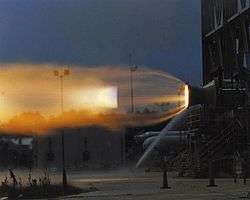TR-106
 | |
| Country of origin | United States |
|---|---|
| Manufacturer | TRW |
| Application | low cost throttleable booster engine |
| Liquid-fuel engine | |
| Propellant | Liquid oxygen / LH2 (liquid hydrogen) |
| Performance | |
| Thrust (SL) | 2,892 kN (650,000 lbf) |
The TR-106 or Low Cost Pintle Engine (LCPE) was a developmental rocket engine designed by TRW under the Space Launch Initiative to reduce the cost of launch services and space flight. Operating on LOX/LH2 the engine had a thrust of 2892 kN, or 650,000 pounds, making it one of the most powerful engines ever constructed.[1]
Overview
The goal of the development was to produce a large, low-cost, easy-to-manufacture booster engine. The design used a single element coaxial pintle injector, a robust type of injector. It also used ablative cooling of the combustion chamber and nozzle instead of the more costly to manufacture regenerative cooling.[1]
The use of the pintle injector allows the engine thrust to be widely throttleable, as was the case for the Lunar Module Descent Engine.[1]
Status
Tom Mueller was a lead engineer for development of the LCPE,[2][3] a 650,000 lbf thrust LOX/LH2 engine. In the summer of 2000, this LCPE was successfully hot fire tested at 100 percent of its rated thrust as well as at a 65 percent throttle condition at NASA's John C. Stennis Space Center in Mississippi.[4] TRW changed the pintle injector configuration three times during testing to explore the engine's performance envelope; engineers also replaced the ablative chamber once while the engine was on the test stand—demonstrating the LCPE's ease of operation. Test results demonstrated that the engine was stable over a wide variety of thrust levels and propellant ratios.[1]
Development of the engine was temporarily discontinued with the cancellation of the Space Launch Initiative.[1] In 2002 TRW was acquired by Northrop Grumman and development of a LOX/RP-1 engine (TR-107) continued, under contract to NASA, for potential use on next-generation launch and space transportation vehicles.[5]
Legacy
Tom Mueller would become TRW vice president of propulsion. In 2002, Elon Musk asked Mueller to join him as a founding member of SpaceX.
Technology lessons from the Low Cost Pintle Engine project were used in the development of the SpaceX Merlin engine.[6][7] Mueller joined SpaceX in 2002, becoming its head of propulsion, along with other TRW staffers.[8] The turbopump, meanwhile, was contracted to Barber-Nichols, Inc., which derived their pump from their work on the FASTRAC turbopump.[9] TRW's parent, Northrop Grummman, then sued for theft of trade secrets.[10][11]
See also
References
- 1 2 3 4 5 "TR-106". Astronautix.com. 2000-09-26. Retrieved 2014-02-17.
- ↑ "Company". SpaceX. 2010-12-08. Retrieved 2014-02-17.
- ↑ Mueller, Tom; Dressler, Gordon. TRW 40 klbf LOX/RP-1 low cost pintle engine test results. 35th AIAA/ASME/SAE/ASEE Joint Propulsion Conference and Exhibit, Huntsville, Alabama, July 24, 2000
- ↑ "Stennis Space Center". Spinoff.nasa.gov. 2011-05-01. Retrieved 2014-02-17.
- ↑ Archived May 23, 2010, at the Wayback Machine.
- ↑ Seedhouse, Eric. SpaceX: Making Commercial Spaceflight a Reality, Springer Science & Business, Jun 15, 2013, p. 36
- ↑ Air & Space Magazine, December 2011/January 2012, p. 25
- ↑ Reingold, Jennifer. Hondas in Space, Fast Company, February 2005
- ↑ "Rocket Engine Turbopumps". Barber Nichols. 1999-04-30. Retrieved 2014-02-17.
- ↑ Karp, Jonathan; Paztor, Andy. Can Defense Contractors Police Their Rivals Without Conflicts? Wall Street Journal, December 28, 2004
- ↑ "Brian Ledahl, Partner - Russ August & Kabat, Los Angeles Intellectual Property Attorney". Raklaw.com. Retrieved 2014-02-17.
